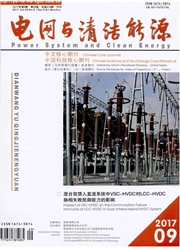

 中文摘要:
中文摘要:
随着智能电网的建设,大规模新能源机组并网运行,使电力系统运行更加复杂,对电网的稳定性提出更高的要求。先导节点的选择及其电压的控制是电力系统稳定性研究的重要方面,节点类型和状态变量扩展潮流计算能为经济调度、参数整定、在线分析估计等提供更全面可靠的参考。以此为目的,建立了一种拓展潮流计算模型。提出通过标准粒子群优化算法在电压控制分区中选择先导节点。提出含P、PV、PQ、PQV、Vθ等多节点类型及拓展变量的潮流计算模型,计及发电机机端电势变量,将已选中枢点设为PQV节点,选择等量的发电机组为P节点。利用IEEE 39节点输电网络选择先导节点和潮流计算仿真,结果验证了该模型的有效性。常规潮流模型与该模型仿真比较表明该模型在今后智能电网背景下离线和在线实时潮流计算中将有很好的应用前景。
 英文摘要:
英文摘要:
With rapid construction of the smart grid and integration of the large-scaled new energy generation units into the power grid, the operation of the power system is increasingly complicated with even high demands on the grid stability. Selection of the guide node and control of its voltage are important in the power system stability study. The expansion of the node types and state variables in the power flow calculation provides a more comprehensive and reliable model for the economic dispatch, parameter settings, and also for online analytic estimates. For this purpose, this paper establishes an expanded new power flow calculation model and proposes that the guide nodes be selected in the voltage-controlled partition by using standard particle swarm optimization algorithm. The paper also puts forward an expanded power flow calculation model which contains P, PV, PQ, PQV, Vθ types of nodes, and taking the terminal potential of the generator into account, and considering the potential variables at the generator side, sets the selected hub node as PQV node and the equal number of generating units as P node. Furthermore, the particle swarm algorithm in the IEEE39 nodes network is used to select the guide nodes and to simulate the power flow calculation based on the new model. The results verify the validity of the model. Compared with the normal power calculation, the new model can realize the voltage control targets and presents a good prospect in the offline and online real-time flow calculations in the context of the smart grid.
 同期刊论文项目
同期刊论文项目
 同项目期刊论文
同项目期刊论文
 期刊信息
期刊信息
